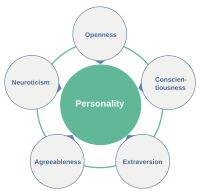
Photo from wikipedia
Conscientiousness is frequently characterized by tendencies to be self-disciplined, to demonstrate organization and dependability, to act dutifully, to aim for achievement and to have good impulse control; this trait plays… Click to show full abstract
Conscientiousness is frequently characterized by tendencies to be self-disciplined, to demonstrate organization and dependability, to act dutifully, to aim for achievement and to have good impulse control; this trait plays an important role in some special contexts, such as legal consciousness. Although a great number of studies have confirmed the impact of conscientiousness on emotion experience, little is known about the relationship between conscientiousness and emotion regulation, or of the brain structural basis that is involved. The current study investigated the neuroanatomical basis of the relationship between conscientiousness and emotion regulation from the perspective of individual differences. The voxel-based morphometry (VBM) method at the whole-brain level was used to identify the brain structural basis related to conscientiousness in a large, young sample (n = 351). The results showed that conscientiousness was significantly and positively correlated with the gray matter volume (GMV) in the right inferior frontal gyrus (IFG), which is the key region for inhibitory control. Further mediation analysis revealed that the IFG volume partially mediated the relation between conscientiousness and expressive suppression (ES), rather than cognitive reappraisal (CR), which showed that the IFG is associated with direct inhibitory control and plays a specific role in the relationship between conscientiousness and the two strategies of emotion regulation. Taken together, these findings contributed to sharpening the understanding of the correlation between conscientiousness and emotion regulation from the perspective of the brain structural basis.
Journal Title: Frontiers in Human Neuroscience
Year Published: 2018
Link to full text (if available)
Share on Social Media: Sign Up to like & get
recommendations!